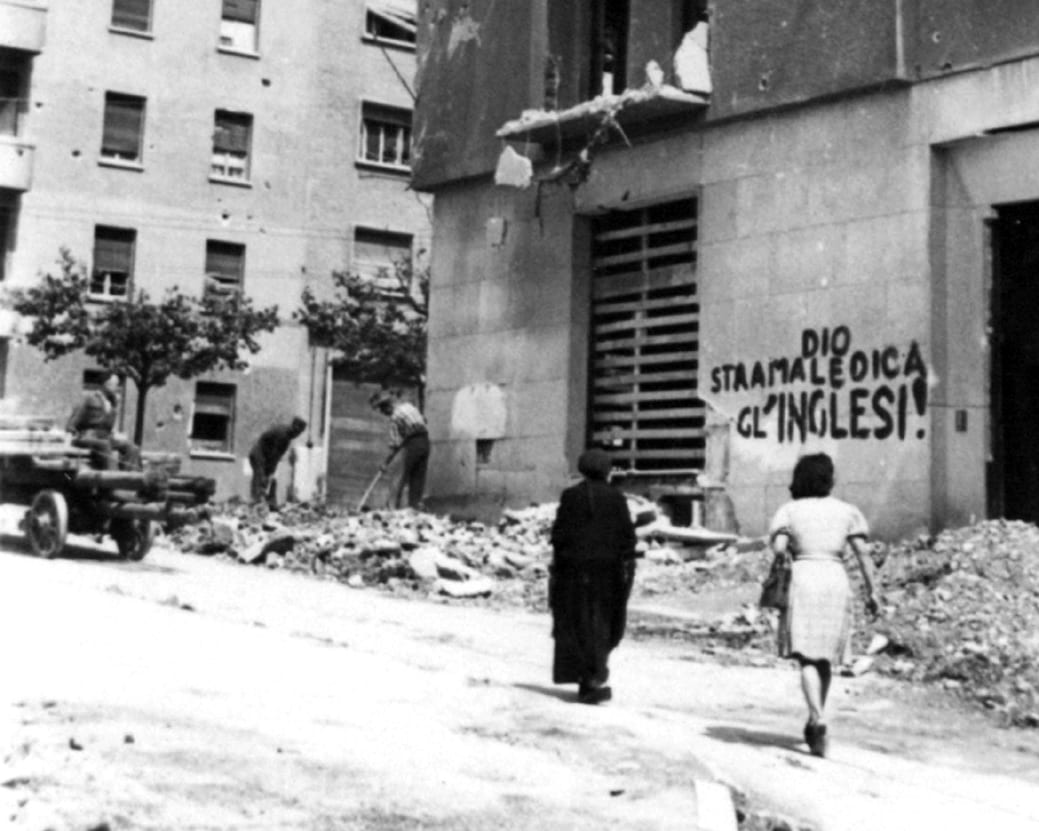Unlike other European countries, there isn’t a received narrative of the bombing war in Italy and aerial warfare has been an inherently divisive topic since the end of the Second World War. Allied air forces have been, at the same time, liberators and tormentors – they were instrumental in ending the war but technically responsible for massive loss of life as well as for destruction of property and cultural heritage on a scale unseen before.
Italian scholars tend to use the notion of memoria divisa (‘un-shared’ memory) as overarching concept in approaching a period of Italian history which remains contentious and divisive. Language itself highlights deep fault lines within Italian society. For instance, Nazi reprisals and mass shooting of civilians are consistently interpreted as war crimes and these events are usually termed eccidio, the erudite and almost literary synonym for bloodbath; victims are frequently presented as martiri (martyrs). Conversely, there isn’t a specific Italian term for the casualties of the bombing war, who are almost invariably described with the most generic term vittime (victims) which is a rather nonspecific noun in modern Italian.
Only a minority of Allied bombings are now remembered with officially-sanctioned public ceremonies, marked by prominent public art, or otherwise memorialised. The perception of bombing war has remained ambiguous and the prevailing aspiration in post war years was simply to forget and move on. Nowadays, the bombing war is still far from being a mainstream topic; it’s rarely covered by media and research has mainly been confined to academic circles or independent researchers who explore the topic from the military history perspective or discuss the facts from a specific political stance. Not surprisingly, the lives and personal stories of people who were caught up in the bombing war have been largely forgotten, except at local level, or shared only among family members.
Since the inception of the project, the Archive team has been liaising with individuals, institutions and organisations which share the core tenets of the International Bomber Command Centre and have expressed interest in collaborative work. I undertook a research trip in July and August 2016 – thirteen meetings were arranged in nine cities over the course of nine days, involving 32 people in total. The Interest in the project was very high and the IBCC’s ethos elicited favourable comments. To begin with, its choice to include military and civilian stories from both sides of the conflict in a spirit of understanding and reconciliation has been systematically praised as comparable initiatives tend to be more limited in scope or have a narrower focus. Unlike the IBCC, integration of professional expertise and voluntary work tends to be used more cautiously and digitisation projects are usually entirely carried out by paid staff.
Three dissertation projects have since been assigned by professors based at the universities of Pavia, Trieste and Venice. Two projects revolve around recording oral history interviews of bombing survivors in Italy. The resulting audio files and associated metadata have been shared with the Archive. Furthermore, there are concrete opportunities that future research agreements will provide even more material on a regular basis. Some of the scholars contacted are respected figures among contemporary historians and may be instrumental in building a support network abroad.
Among the Italian volunteers trained to conduct oral history interviews, there are five public historians belonging to the Lapsus association. They have delivered excellent results, working with minimal supervision thanks to a well-established network of local contacts.
Three Italian volunteers have spent a total 12 weeks in Lincoln, helping out as OH interviewers, transcribers, researchers, metadata creators, and event support staff.
Contacts with local specialists and cultural heritage institutions have led to veritable treasure trove of documents which shed a unique light on the lives of those who were at the receiving end of the bombing war: propaganda posters and leaflets, correspondence, toys, and everyday objects excavated from shelters. The most striking piece is probably a board game from the 1930s devised to teach young children anti-aircraft precautions. It is in surprisingly good condition for an object of such vintage and will be featured in the civilian gallery of the exhibition. The archive also managed to get permission to reproduce the temperas of a self-taught wartime artist who explored a broad range of subjects, including Royal Navy actions and well-known Bomber Command operations such as the bombing of Dresden and the attacks of the Möhne, Eder and Sorpe dams led by Victoria Cross recipient Guy Gibson. Other works focus on Nazi brutalities, the deeds of the resistance movements, as well as civilian life in wartime Europe: bomb disposal units, and British evaders being helped by civilians. The emotional intensity of the events depicted emerges strongly from each image and some of them have been selected for the exhibition panels.
Alessandro Pesaro, Digital Archive Developer

